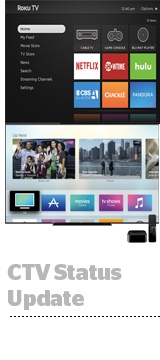 Despite the perception that over-the-top TV (OTT) supports digital ad-buying tactics – like dynamic insertion and targeting at scale – buying connected TV is still a largely manual process.
Despite the perception that over-the-top TV (OTT) supports digital ad-buying tactics – like dynamic insertion and targeting at scale – buying connected TV is still a largely manual process.
“Everything we do right now is I/O-direct with publishers,” said Seth Walters, senior partner for interactive and connected TV (CTV) for WPP’s advanced TV agency, Modi Media.
Tal Chalozin, co-founder and CTO of the interactive TV ad server Innovid, also noted that almost everything bought on over-the-top devices today is done so directly or on an I/O basis.
Theoretically, programmatic buying could combine inventory and add scale – there’s just not a lot of premium, broadcast-caliber video inventory out there to pool.
“You do see [programmatic vendors] getting into OTT, but there’s still very little inventory out there,” Chalozin said. “Volumewise, guys like Hulu, Fox or ESPN are the big sellers of impressions.” (For the purposes of this article, CTV is assumed to be a subset of OTT.)
Advanced TV buyers like Modi are used to aggregating their direct buys to accumulate reach and manage frequency across multiple over-the-top publishers, but it takes a lot of sweat equity.
The kind of cross-platform targeting and measurement found in digital is often harder to put into practice in OTT.
Oleg Korenfeld, EVP of ad tech and platforms at Mediavest Spark, said publisher and platform idiosyncrasies are what complicate OTT targeting today for most buyers.
“You have devices like Roku, Amazon Fire TV and Xbox, and then publishers like Hulu, Crackle and NBC, each with different rules,” he said. “The methodology should be there to deliver better audience measurement and targeting across the board, but it’s up to individual publishers to help you understand reach across devices and it’s up to the buy side to push for it.”
Once more automation comes to the buying process, and measurement advances, more dollars will eventually flow, industry insiders predict.
And more data is being activated in OTT campaigns. Many buyers rely on authenticated data from individual publishers to attribute their ad exposures.
But until industry standards cover both device- and publisher/app-level data, OTT measurement is basically “semi-touch” attribution,” Korenfeld said.
The issue is data inconsistency across devices and apps. A consumer might give Roku or Hulu their age and birthday – but individual apps, such as Vevo, for example, might not be privy to that information.
“This is why Facebook is making a bigger play in OTT,” said Innovid’s Chalozin. “They already started buying media from A&E and Tubi TV to add OTT to their audience network, which could bring more census-level data into OTT.”
Another challenge is not all platforms package audiences equally.
Roku offers advertisers pre-qualified audiences through a program called Roku Audience Access, which allows buyers to go beyond the basics of contextual targeting. But a device like Apple TV doesn’t enable the same kind of audience targeting.
“In the meantime, we need to take a different approach to targeting on those devices, which will come more from the publishers that represent their video inventory on Apple TV,” Walters said. (Or, from the likes of Facebook, which is starting to sell ads via its audience network through individual apps on Apple TV and Roku.)
Powering New Attribution Models
Beyond measuring initial media exposures, advanced TV buyers like Modi must do a lot of heavy lifting themselves to prove attribution out in CTV.
Modi works with device partners like Roku (or other streaming providers) to match users at the (anonymized) subscriber or device-registration level.
Modi can then layer in purchase or credit card data or match those users to IP addresses using cookies, to attribute CTV views to other conversion or performance-based metrics.
“We’re working with Experian to pixel our media and match it back to their DMP, which can be translated into a household or Experian ID at the individual level,” Walters said. “From there, we can look at the impact of our campaigns against any form of post-campaign metric, whether that’s sales or web traffic or visits to a brick-and-mortar location based on exposure to CTV.”
OTT suppliers like Hulu are fielding more requests from advertisers for advanced measurement models, which is why it is piloting deeper attribution to link Hulu ads to in-store foot traffic and purchasing, said Julie DeTraglia, head of ad sales research for Hulu.
“We have this benefit of census-level exposure data at the household level, which makes it easier to do, but the question of the year is, when will we have consistent, holistic, standardized measurement across every platform?” she said. “Nielsen delayed the initial public launch of their total audience project, namely because it’s really hard to do. This only happens if the industry collectively collaborates.”
This post was syndicated from Ad Exchanger.

More Stories
Best Buy and CNET Are Combining Their Ad Inventory
Buyers Are Wasting Money on Alt IDs While Cookies Still Persist
Ibotta Crosses The IPO Finish Line – Now The Real Work Begins